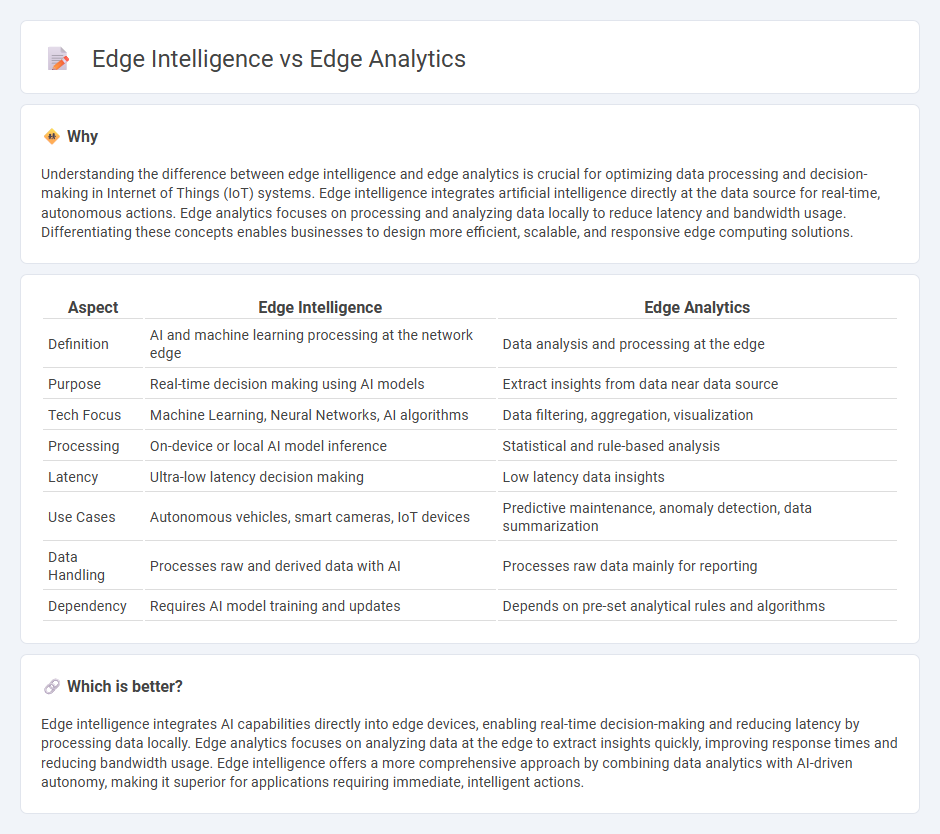
Edge intelligence integrates artificial intelligence capabilities directly into edge computing devices, enabling real-time decision-making and autonomous operations. Edge analytics focuses on processing and analyzing data locally at the edge to minimize latency and reduce bandwidth usage. Explore the differences and applications of edge intelligence versus edge analytics to enhance your understanding of modern computing technologies.
Why it is important
Understanding the difference between edge intelligence and edge analytics is crucial for optimizing data processing and decision-making in Internet of Things (IoT) systems. Edge intelligence integrates artificial intelligence directly at the data source for real-time, autonomous actions. Edge analytics focuses on processing and analyzing data locally to reduce latency and bandwidth usage. Differentiating these concepts enables businesses to design more efficient, scalable, and responsive edge computing solutions.
Comparison Table
| Aspect | Edge Intelligence | Edge Analytics |
|---|---|---|
| Definition | AI and machine learning processing at the network edge | Data analysis and processing at the edge |
| Purpose | Real-time decision making using AI models | Extract insights from data near data source |
| Tech Focus | Machine Learning, Neural Networks, AI algorithms | Data filtering, aggregation, visualization |
| Processing | On-device or local AI model inference | Statistical and rule-based analysis |
| Latency | Ultra-low latency decision making | Low latency data insights |
| Use Cases | Autonomous vehicles, smart cameras, IoT devices | Predictive maintenance, anomaly detection, data summarization |
| Data Handling | Processes raw and derived data with AI | Processes raw data mainly for reporting |
| Dependency | Requires AI model training and updates | Depends on pre-set analytical rules and algorithms |
Which is better?
Edge intelligence integrates AI capabilities directly into edge devices, enabling real-time decision-making and reducing latency by processing data locally. Edge analytics focuses on analyzing data at the edge to extract insights quickly, improving response times and reducing bandwidth usage. Edge intelligence offers a more comprehensive approach by combining data analytics with AI-driven autonomy, making it superior for applications requiring immediate, intelligent actions.
Connection
Edge intelligence integrates artificial intelligence capabilities directly into edge devices, enabling real-time decision-making and data processing close to the data source. Edge analytics involves analyzing data locally on edge devices, reducing latency and bandwidth usage while enhancing response times. Together, edge intelligence and edge analytics drive efficient, intelligent systems by combining local data analysis with AI-driven insights at the network edge.
Key Terms
Data Processing Location
Edge analytics processes data locally on edge devices, minimizing latency and reducing bandwidth usage by analyzing information near the data source. Edge intelligence combines edge analytics with AI capabilities, enabling autonomous decision-making and real-time responses without relying on centralized cloud systems. Explore our detailed comparison to understand which approach suits your IoT or industrial AI needs best.
Real-time Decision-Making
Edge analytics processes data locally on devices to generate real-time insights, reducing latency and bandwidth usage by analyzing data near its source. Edge intelligence extends edge analytics by integrating AI and machine learning models at the edge, enabling autonomous decision-making and adaptive responses without relying on cloud connectivity. Explore more to understand how these technologies transform real-time decision-making across industries.
Machine Learning Integration
Edge analytics processes and analyzes data locally on edge devices, minimizing latency and reducing bandwidth use by performing real-time analytics close to the data source. Edge intelligence incorporates advanced machine learning models directly on edge devices to enable autonomous decision-making, adaptive learning, and predictive insights without relying on central cloud systems. Explore how integrating machine learning with edge technologies transforms data-driven applications for enhanced efficiency and responsiveness.
Source and External Links
What is Edge Analytics | Glossary | HPE - Edge analytics is the process of analyzing data at or near its source, such as IoT devices, which reduces latency, optimizes bandwidth, and enables real-time, localized decision-making.
What is edge analytics? | Definition from TechTarget - Edge analytics enables automated data analysis directly at the sensor or device level, allowing immediate response and reducing the need to transfer large volumes of data to centralized systems for processing.
What Is Edge Analytics? - Pure Storage - Edge analytics refers to analyzing data at the edge of the network (close to where it is generated), which is especially valuable in IoT applications for fast, real-time insights and more efficient resource use.
 dowidth.com
dowidth.com